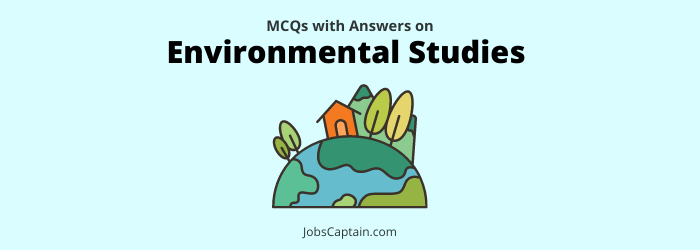
Question 1. The pyramid of numbers is given by?
(A) Tansley
(B) Elton
(C) Odum
(D) Haeckel
Question 2. A food web consists of ___________.
(A) A set of similar consumers
(B) A portion of a food chain
(C) Producers, consumers and decomposers
(D) Interlocking food chains
Question 3. An ecosystem may not undergo changes because ___________.
(A) The decomposers are present in it
(B) It gets solar energy continuously
(C) It has plants and animals both
(D) It is in a state of homeostasis
Question 4. Tendency of pollutants to become concentrated in successive trophic levels is known as ___________.
(A) Biopiracy
(B) Bioremediation
(C) Biorhythm
(D) Biomagnification
Question 5. Which ecological pyramid is always upright?
(A) Pyramid of number
(B) Pyramid of biomass
(C) Pyramid of energy
(D) Pyramid of number and biomass
Question 6. Which one is the correct food chain?
(A) Grass —» Fish —» Zooplankton
(B) Zooplankton —» Protozoans —» Fish
(C) Zooplankton —» Phytoplankton —» Fish
(D) Phytoplankton —» Zooplankton —» Fish
Question 7. The desert among the following which is not a cold desert is ___________.
(A) Majava desert
(B) Atacama desert
(C) Patagonian desert
(D) Golbi desert
Question 8. Eutrophication is ___________.
(A) A water purification
(B) A process in the carbon cycle
(C) The result of accumulation of plant nutrients in water bodies
(D) An improved water quality status of lakes
Question 9. An ecological pyramid refers to the________.
(A) Pyramid of number
(B) Pyramid of biomass
(C) Pyramid of energy
(D) All of the above
Question 10. Food webs are ___________.
(A) Linear arrangement of food chains
(B) Inter-connected arrangement of food chains
(C) Not related to food chains at all
(D) One kind of food
Question 11. Increase in fauna and decrease in flora would be harmful due to increase in ___________.
(A) Radioactive pollution
(B) O2
(C) CO
(D) Diseases
Question 12. Overgrazing results in ___________.
(A) Productive soils
(B) Soil erosion
(C) Retention of useful species
(D) All of the above
Question 13. ‘Smog’ is a mixture of ___________.
(A) Sulphur Dioxide and Fog
(B) Snow and Dust
(C) Snow and Fog
(D) Smoke and Fog
Question 14. A product of photosynthesis is?
(A) Chlorophyll
(B) Oxygen
(C) Water
(D) Carbon dioxide
Question 15. Carbon dioxide constitutes about 0.03% of the atmosphere _________.
(A) By mass
(B) By weight
(C) By volume
(D) None of these
Question 16. The primary producers in a forest ecosystem are ___________.
(A) Bacteria and other micro-organism
(B) Carnivores
(C) Herbivores
(D) Chlorophyll containing trees and plants
Question 17. The darker zone in lakes where light penetration is negligible is called the ___________.
(A) Benthic zone
(B) Limnetic zone
(C) Littoral zone
(D) Euphotic zone
Question 18. A liquid fuel that was formed from the ancient remains of sea plants and animals is?
(A) Coal
(B) Geothermal energy
(C) Petroleum
(D) Natural gas
Question 19. The atmosphere consists of 79 percent Nitrogen and 21 percent Oxygen by?
(A) Density
(B) Weight
(C) Volume
(D) All of these
Question 20. Energy from the heat inside the earth is?
(A) Terrathermal
(B) Petroleum
(C) Geothermal
(D) Natural gas
Question 21. Development activities on the hydrosphere cause ___________.
(A) Soil erosion
(B) Water pollution
(C) Soil pollution
(D) Air pollution
Question 22. The largest reservoir of nitrogen in our planet is ___________.
(A) Fossil fuels
(B) Biosphere
(C) Atmosphere
(D) Ocean
Question 23. A poisonous gas given out of vehicles exhaust is?
(A) Carbon dioxide
(B) Methane
(C) Ethane
(D) Carbon monoxide
Question 24. The zone of a sea lying over the continental shelf is known as the ___________.
(A) Littoral zone
(B) Abyssal zone
(C) Neritic zone
(D) Bathyl zone
Question 25. Energy flow in an ecosystem is always ___________.
(A) Multi-directional
(B) Reversible
(C) Cyclic
(D) Unidirectional
